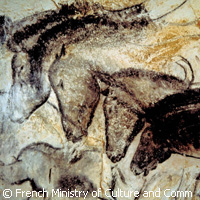Ancient horse DNA confirms realistic cave paintings
Are works of art from the Palaeolithic period reflections of the natural environment? An international team of scientists has used ancient deoxyribonucleic acid (DNA) to unlock the mystery of how horses depicted in prehistoric cave paintings are lifelike in nature. Presented in the journal Proceedings of the National Academy of Sciences (PNAS), the results show that all the colour variations observed in Palaeolithic cave paintings, even 'leopard' spotting, existed in pre-domestic horse populations. The study helps corroborate the theory that artists were reflecting their natural environment and substantiates white spotted phenotypes in pre-domestic horses. Until now, DNA studies had only succeeded in confirming results for bay and black horses. In this study, scientists from Germany, Mexico, Russia, Spain, the United Kingdom and the Unites States genotyped and evaluated 9 coat-colour loci in 31 pre-domestic horses dating back as far as 35,000 years ago from western and eastern Europe, as well as Siberia and the Iberian Peninsula. The team assessed bones and teeth specimens collected from 15 sites. The data show how a gene linked to leopard spotting was shared by four Pleistocene and two Copper Age samples from both western and eastern Europe. This discovery confirms the existence of spotted horses. The results also provide insight on how all colour phenotypes discernible in cave paintings (bay, black and spotted) existed in pre-domestic horse populations. The team notes how the leopard complex phenotype was rare, particularly after losing ground compared to other phenotypes. But in recent times, the leopard complex has been gaining ground, becoming a favoured phenotype in a number of horse breeds like Appaloosa and Noriker. 'Our breeding efforts have intensified again because there is a growing interest in the restoration of these horses,' says Dr Monika Reissmann from the Department for Crop and Animal Sciences at Humboldt University in Germany. 'Our results suggest that, at least for wild horses, Palaeolithic cave paintings, including the remarkable depictions of spotted horses, were closely rooted in the real-life appearance of animals,' explains Michi Hofreiter, a professor from the Department of Biology at the University of York in the United Kingdom. 'While previous DNA studies have produced evidence for bay and black horses, our study has demonstrated that the leopard complex spotting phenotype was also already present in ancient horses and was accurately depicted by their human contemporaries nearly 25,000 years ago.' Professor Hofreiter goes on to say that the results of the study add weight to the belief that the cave paintings may contain less of a symbolic connotation than what is usually considered, and are representative of humans' natural environment. Commenting on the study and work involved, Dr Melanie Pruvost of the Berlin-based Leibniz Institute for Zoo and Wildlife Research and the German Archaeological Institute says: 'We are just starting to have the genetic tools to access the appearance of past animals and there are still a lot of question marks and phenotypes for which the genetic process has not yet been described. However, we can already see that this kind of study will greatly improve our knowledge about the past. Knowing that leopard spotting horses were present during the Pleistocene in Europe provides new arguments or insights for archaeologists to interpret cave arts.'For more information, please visit: PNAS:http://www.pnas.org/University of York:http://www.york.ac.uk/
Countries
Germany, Spain, Mexico, Russia, United Kingdom, United States



